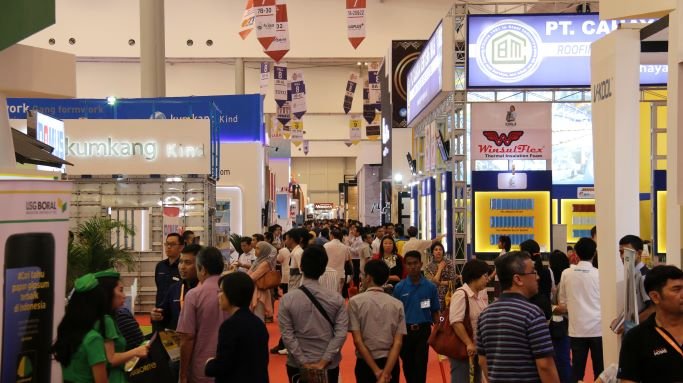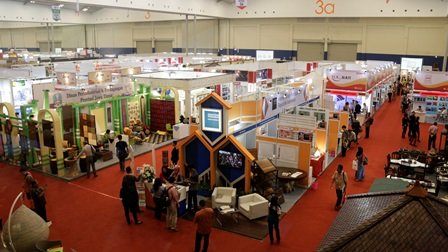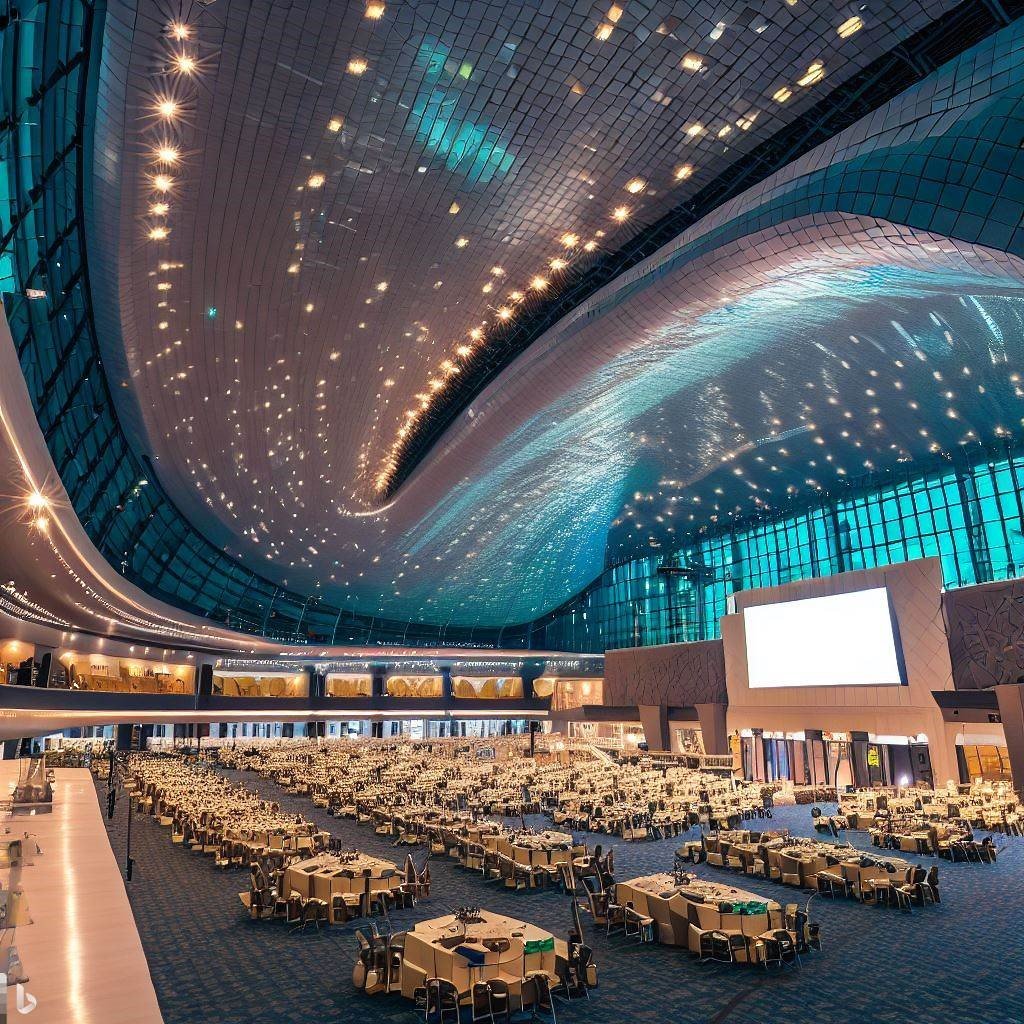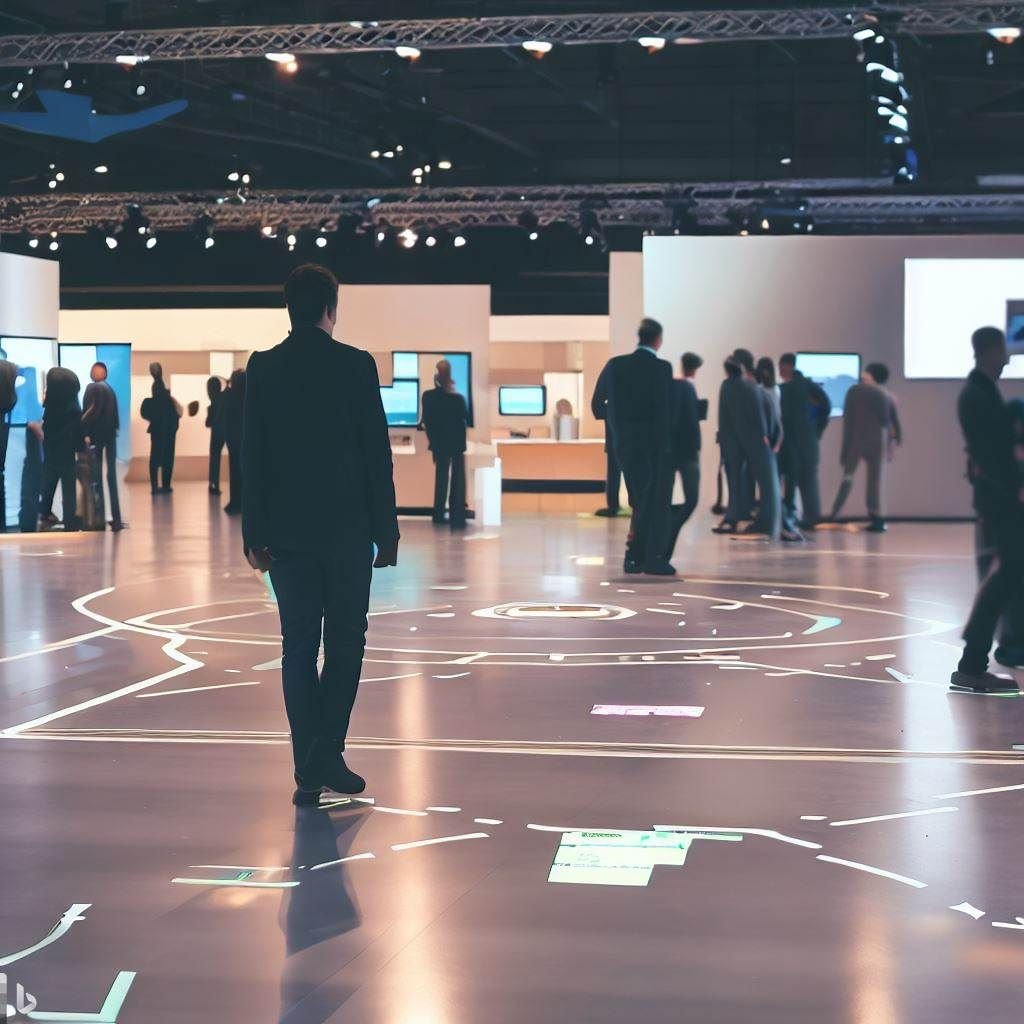1. INVEA’s 30 Key points for a sustainable exhibition and convention venue

INVEA’s 30 Key points for a sustainable exhibition and convention venue
Sustainability is becoming an increasingly important issue in our society, and exhibition venues have a significant impact on the environment due to the large amount of energy, water, and materials required to host events. As such, it is essential to make exhibition venues more sustainable to reduce their environmental impact. In the article below your will find INVEA’s 30 key points to make an exhibition venue more sustainable whilst at the same time reducing the carbon footprint for venue owners, event organizers, exhibitors and attendees.
To rank these 30 key points in order of importance and impact on carbon footprint is difficult as each point is important and has a significant impact on reducing the carbon footprint of an exhibition venue. However, we attempt to list them in a somewhat logical order based on their potential impact.
- Use renewable energy sources such as solar or wind power to reduce reliance on fossil fuels. Venue management can invest in renewable energy sources by installing solar panels or wind turbines. Alternatively, they can purchase renewable energy credits to offset their energy usage. Event organizers can prioritize venues that use renewable energy sources, and exhibitors can use energy-efficient equipment.
- Install energy-efficient lighting systems and appliances to reduce energy consumption.
Venue management can replace outdated lighting systems and appliances with energy-efficient ones. Event organizers can require exhibitors to use energy-efficient equipment and lighting. - Encourage exhibitors to use LED lighting which is energy efficient and long-lasting.
- Use motion sensor lighting. Use motion sensor lighting to reduce energy usage when rooms are not in use.
- As a venue, use natural ventilation to reduce the need for air conditioning, thus lowering your energy needs and cost.
- As a venue use smart building technologies to optimize energy usage and reduce waste.
- Implement a waste management plan to reduce waste generated from exhibitions and events. Venue management can develop a waste management plan that includes recycling and composting facilities. Event organizers can require exhibitors to use recyclable and compostable materials, and attendees can be encouraged to recycle and compost.
- Use low-flow water fixtures and efficient toilets to reduce water usage.Venue management can install low-flow water fixtures and efficient toilets to reduce water usage.
- Offer water refill stations. Provide water refill stations to encourage the use of reusable water bottles by exhibitors and attendees.
- Encourage exhibitors to use sustainable materials and products. Event organizers can provide exhibitors with a list of sustainable materials and products that they can use for their displays and exhibits.
- Encourage exhibitors to reuse materials for their displays and exhibits.
- Minimize the use of printed materials and use digital alternatives, such as mobile apps and online platforms or content for download instead.
- Use renewable materials for construction and design, such as bamboo or recycled materials. Avoid carpeting in the alleys if possible or switch to sustainable material options.
- Provide recycling and composting facilities for attendees and exhibitors - Venue management can provide recycling and composting facilities throughout the venue. Event organizers can communicate the location of these facilities to attendees and exhibitors.
- Use sustainable and non-toxic cleaning products. Venue management can use environmentally friendly cleaning products. Event organizers can communicate the use of these products to exhibitors and attendees.
- Event organizers can encourage attendees to use public transportation or carpool to the event. Venue management can provide shuttle buses or designate parking areas for carpooling. Incentivize the use of public transportation and carpooling.
- Use digital signage and communications instead of printed materials. Venue Owners and Event organizers can use digital signage and communications to reduce the use of printed materials. Exhibitors can provide digital marketing materials rather than printed handouts.
- Use sustainable and biodegradable materials for all event materials and packaging. Venue F&B should apply reusable catering equipment such as plates and cutlery or use sustainable and biodegradable options. Event organizers can encourage exhibitors to use sustainable and biodegradable materials for packaging, displays and handouts.
- Use locally sourced and organic food and beverage options. Venue management can work with local vendors to provide locally sourced and organic food and beverage options. Event organizers can communicate the availability of these options to attendees and exhibitors.
- Implement a green procurement policy for all goods and services. Venue management can implement a green procurement policy that prioritizes environmentally friendly goods and services.
- Venue management can install rainwater harvesting systems for landscaping and other non-potable water needs such as toilets.
- Implement green roofs and walls to help with insulation, air quality, and biodiversity. Venue management can implement green roofs and walls to improve insulation, air quality, and biodiversity. Green roofs can be used to provide additional sustainably grown, organic food to be used in venue catering services.
- Implement a bike-share program for attendees and staff. Venue management can provide a bike-share program for attendees and staff to encourage sustainable transportation.
- Use energy-efficient HVAC systems and insulation to reduce heating and cooling needs. Venue management can use energy-efficient HVAC systems and insulation to reduce heating and cooling needs.
- Implement a sustainable transportation plan for all event-related transportation. Event organizers can implement a sustainable transportation plan that prioritizes sustainable modes of transportation.
- Offer incentives for exhibitors and attendees who make sustainable choices. Event organizers can offer incentives such as discounts or prizes to exhibitors and attendees who make sustainable choices. For example, exhibitors who use sustainable materials or practices could be given preferential booth locations or discounts on booth fees. Attendees who use public transportation or bring reusable water bottles could be entered into a prize drawing.
- Provide education and training on sustainable practices. Event organizers can provide education and training sessions for exhibitors and attendees on sustainable practices. This could include information on recycling and composting, energy-efficient equipment, and sustainable transportation options.
- As event organizer choose a venue with green certifications such as LEED or BREEAM to host your event. As exhibitor choose an event that provides a clear approach and strategy towards sustainability and net zero carbon initiatives.
- Implement a carbon offset program. Implement a carbon offset program to mitigate the environmental impact of the event.
- Monitor and track sustainability metrics to measure progress. Venue management, event organizers, and exhibitors can monitor and track sustainability metrics to measure progress and identify areas for improvement. Metrics could include energy and water usage, waste diversion rates, and carbon emissions from transportation. This information can then be used to set sustainability goals and develop strategies to achieve them. It will also provide a great basis to market the event in terms of sustainability and carbon footprint.
Implementing these key points requires a collaborative effort between venue management, event organizers, exhibitors, and attendees. While there will be challenges and costs associated with implementing sustainable practices, the long-term benefits of reduced carbon footprint and increased environmental responsibility are worth the effort. By implementing sustainable practices, exhibition venues can reduce their carbon footprint and contribute to a more sustainable future.
Please contact INVEA Ltd. for more information and let us help you on your journey to become a more sustainable venue.
2. Increasing your exhibition and conference center occupancy rate

Increasing your exhibition and conference center occupancy rate – INVEA’s 6 simple strategies will get you started.
Exhibition venues and conference centers are essential components of the business landscape, providing valuable space for companies and organizations to showcase their products, services, ideas, boost the company image and displaying latest industry trends. However, increasing occupancy rates in these venues can be a challenging task, particularly in an increasingly competitive market with rapidly changing customer needs and marketing programs. INVEA’s strategies can help boost exhibition venue and conference center occupancy rates:
- Strategic Marketing
To create an effective marketing plan, it's important to first identify your target audience. Consider the types of events that typically take place in your venue, the demographic and the needs of the attendees. From there, develop messages that resonate with your audience and highlight the unique features of your venue. Use a variety of marketing channels, such as social media, email campaigns and digital advertising to reach your target audience. Consider working with a marketing agency or specialist who can develop and execute a comprehensive marketing strategy. It is also important to track the success of your marketing efforts by collecting data on website traffic, social media activities, and event bookings.
2. Partnering with Event Planners
To build relationships with event planners, attend MICE industry conferences and trade shows and network with professionals in the event planning industry. Offer to give tours of your venue and provide detailed information on the amenities and services you offer. Develop partnerships with event planners by offering service and pricing packages, providing customized experiences and offering support throughout the planning process. Consider creating a referral program that rewards event planners for bringing new business to your venue. Also, make sure to collect feedback from event planners and use it to improve the overall experience for future events.
3. Competitive Pricing
To offer competitive pricing, research the prices of similar venues in your area and adjust your prices accordingly. Consider offering preferable rates for early bookings, multiple bookings and long-term commitments. It is important to strike a balance between competitive pricing and maintaining profitability. Consider creating a pricing strategy that takes into account peak and off-peak seasons, as well as the availability of your venue. Stay informed about government subsidy and incentive programs to pass onto your clients.
4. Enhancing Amenities
To enhance amenities, consider investing in the latest technology, such as 5G, video conferencing and interactive displays. Offer catering services that cater to a variety of customer demands and dietary needs, such as vegetarian, gluten-free and kosher options. Provide a dedicated event management team that can handle all aspects of the event from planning to execution. Consider offering unique features, such as live streaming, virtual reality or interactive exhibits, that set your venue apart from competitors. It's also important to regularly update and maintain the amenities to ensure they are in good working order.
5. Creating Partnerships
To create partnerships with local businesses and organizations, identify these in your area that are relevant to your target audience. Consider reaching out to all types of accommodation, like hotels, etc., or transportation services and attractions to develop partnerships that offer added value to customers. Offer special packages or promotions to customers who utilize your partnerships. Consider promoting your partnerships on your website and marketing materials to increase visibility and encourage customers to take advantage of the added value.
6. Cooperating with Associations and Government Institutions
Cooperating with associations and government institutions can be an effective way to increase occupancy rates in exhibition venues and conference centers. Many industries have trade associations that organize events conferences, and seminars/meetings, and these associations can be a great source of business for venues. Identify the associations in your area as well as on a national / international level and reach out to them to offer your venue as a potential location for their events. Building relationships with these associations can lead to repeat business via word-of-mouth recommendations. Additionally, working with government institutions such as tourism boards and convention and visitor bureaus can help increase visibility and attract more visitors / attendees to your area. Consider offering special packages or promotions for association events or government-sponsored conferences to incentivize them to book your venue. Make sure to highlight the benefits of your venue, such as the amenities, location, accessibility, and services to stand out from competitors.
Implementing these strategies can help boost occupancy rates in exhibition venues and conference centers. By focusing on strategic marketing, partnering with event planners, competitive pricing, enhancing amenities, and creating partnerships with local businesses, associations and government institutions, venues can increase their appeal and generate more interest from potential customers.
As you can imagine there is a lot more one can do to increase occupancy rates. Please contact us if you want to learn more.
3. Professional Facility Operations

Professional facility operations are crucial for businesses and organizations of all sizes. From ensuring efficient functioning and compliance with regulations to promoting safety and security, cost-effectiveness, and reputation, professional facility operations play a critical role in the success of any organization.
Efficient functioning is a crucial aspect of professional facility operations, and it requires a proactive approach. To implement efficient functioning, it's important to ensure that all equipment and systems are regularly maintained and optimized for performance. Additionally, regular monitoring and analysis of performance metrics can help identify areas for improvement.
Compliance with regulations is vital for any business, and it's important to stay up-to-date with all regulations and standards applicable to your facility. Implementing a compliance program that includes regular reviews of regulations, training employees on regulations and standards, and conducting regular audits can help ensure that your facility stays compliant.
Safety and security should be a top priority for any facility. To achieve this, it's important to implement and maintain safety protocols, conduct regular safety training for employees, and monitor and update security systems regularly. Additionally, conducting regular risk assessments can help identify potential safety and security hazards and implement corrective measures.
Cost-effectiveness is essential for any business. Implementing an energy management program, using predictive maintenance, and optimizing processes and equipment can help reduce costs while maintaining optimal facility operations.
Enhanced reputation is yet another crucial aspect of professional facility operations, and it requires consistent effort. Maintaining a clean, organized, and safe facility, conducting regular employee training, and actively engaging with customers can help enhance your facility's reputation.
Environmental sustainability is now more than ever an important consideration for many businesses, and it requires a comprehensive approach. Implementing green initiatives, such as using renewable energy sources, reducing waste, and implementing sustainable practices, can help reduce the facility's carbon footprint and promote sustainability.
Another core aspect of professional facility operations is risk management. Implementing a risk management program that includes regular risk assessments, identifying potential risks, and implementing corrective measures can help mitigate risks and ensure safe and efficient operations.
Emergency preparedness is also a basic requirement for any facility. Implementing an emergency preparedness plan that includes regular training, testing, and updating emergency response plans can help ensure that your facility is prepared to handle emergencies effectively.
Secure and professional data management is a must! Implementing a data management program that includes data collection, analysis, safety and reporting can help optimize operations and identify areas for improvement.
As for any business continuous improvement is essential when it comes to facility operation and it requires a culture of challenging the status quo, open discussion, continuous learning and willingness to think outside the box. Implementing a continuous improvement program that includes regular reviews, identifying areas for improvement, and implementing corrective measures can help ensure that your facility continues to improve over time.
In a nutshell: professional facility operations require a comprehensive and proactive approach that addresses all aspects of facility operations. Implementing the ten most important points discussed here can help ensure efficient functioning, compliance with regulations, safety and security, cost-effectiveness, enhanced reputation, environmental sustainability, risk management, emergency preparedness, data management, and continuous improvement.
4. How to build a skilled and professional facility operations team

How to build a skilled and professional facility operations team
Building a professional facility operations organization requires careful planning and execution. Here are some steps to consider when building a professional facility operations organization:
Determine the scope of facility operations: Before building a professional facility operations organization, it's important to determine the scope of facility operations. This includes identifying the types of facilities to be managed, the size of the facilities, the complexity of operations, and the budget available.
Define roles and responsibilities: Once the scope of facility operations has been determined, it's important to define roles and responsibilities. This includes identifying the functions that will be performed in-house and those that will be outsourced. It's also important to define roles and responsibilities for each position within the facility operations organization.
Hire qualified personnel: Hiring qualified personnel is critical to building a professional facility operations organization. This includes identifying the necessary qualifications, experience, and certifications required for each position within the organization. It's also important to identify the necessary soft skills, such as communication and leadership abilities.
Develop policies and procedures: Developing policies and procedures is essential for building a professional facility operations organization. This includes developing policies and procedures related to maintenance, cleaning, internal services, safety, security, emergency preparedness, risk management, and environmental sustainability. It's also important to develop policies and procedures related to procurement, budgeting, and project management.
Implement training programs: Implementing training programs is important to ensure that personnel within the facility operations organization have the necessary skills and knowledge to perform their jobs effectively. This includes developing training programs related to facility management, safety, security, emergency preparedness, and environmental sustainability. It's also important to provide ongoing training and professional development opportunities.
Implement performance metrics: Implementing performance metrics is important to measure the effectiveness of the facility operations organization. This includes identifying key performance indicators (KPIs) related to efficiency, cost-effectiveness, safety, and customer satisfaction. It's also important to develop a system for monitoring and analyzing performance metrics.
Establish partnerships with vendors and suppliers: Establishing partnerships with vendors and suppliers is essential for building a professional facility operations organization. This includes identifying vendors and suppliers that can provide high-quality products and services at a competitive price. It's also important to develop partnerships based on trust, communication, and collaboration.
Utilize technology: Utilizing technology is important for building a professional facility operations organization. This includes implementing a computerized maintenance management system (CMMS) to manage maintenance activities, implementing security systems and monitoring tools, and using data analytics to optimize operations.
5. The Importance of Increasing Revenue and Controlling Costs in Exhibition and Convention Venue Mgmt.

STRIKING THE BALANCE - The Importance of Increasing Revenue and Controlling Costs in Exhibition and Convention Venue Management
In the world of exhibition and convention venue management, a delicate balance between increasing revenue and controlling costs is paramount for long-term success and sustainability. As these venues serve as crucial hubs for large-scale events, conferences, and trade shows, effective financial management becomes essential to maintain profitability, enhance customer experiences, and drive industry growth. This article explores the significance of simultaneously boosting revenue and keeping costs under control in exhibition and convention venue management and operation.
Exhibition and convention venues are not only event spaces but also multifaceted business entities with various revenue-generating opportunities. By actively pursuing diverse revenue streams, these venues can achieve financial stability and unlock their full potential.
While revenue growth is vital, it is equally important to manage costs effectively to ensure financial viability. Prudent cost management strategies enable venues to maintain competitive pricing, invest in infrastructure improvements, assure operational and event safety & security, and sustain long term profitability.
To achieve these goals INVEA has developed a unique toolbox of more than 200 individual measures that will help your venue to generate more revenue whilst optimizing cost without sacrificing on service and venue quality. We have clustered these initiatives in the following areas:
REVENUE INCREASE
A) Strategic measures
B) Facility Operation
C) Services
D) Sales
E) Marketing
F) Customer Relation and Communication
G) Other
COST CONTROL
A) Strategic measures
B) Sustainability
C) FM and Operation
D) Services
E) Other
Let’s discuss your needs and how INVEA can help you to achieve your goals.
6. Overcoming Challenges in New MICE Development Projects

IF YOU DO IT – DO IT RIGHT
Overcoming Challenges in New MICE Development Projects
The Meetings, Incentives, Conferences, and Exhibitions (MICE) industry plays a pivotal role in driving economic growth and fostering international collaboration. As the demand for world-class event destinations continues to rise, new MICE development projects are being undertaken worldwide. However, these projects are not without their share of challenges that range from financial considerations to infrastructure development, market positioning, sustainability, stakeholder collaboration and adaptability. Here are some of the key hurdles faced by stakeholders involved in the development of MICE projects and how to overcome them.
In an increasingly competitive landscape, positioning a new MICE destination as an attractive choice for event organizers and attendees is crucial. Competing against established destinations with established networks and reputations poses a significant challenge. Doing your homework by conducting a detailed feasibility study and comprehensive market research, understanding target audience needs, developing unique selling propositions, and implementing robust marketing and promotional strategies are essential to establish a successful MICE venue development project.
This is closely followed by conceptualizing and later on creating state-of-the-art infrastructure and facilities for successful MICE destinations. It involves designing and constructing convention centers, exhibition halls, hotels, transportation networks, and digital infrastructure. Ensuring that these facilities meet international standards, are flexible enough to accommodate various event types and sizes, and provide advanced technological capabilities can be a complex task. Strong project management, engagement with experienced consultants, and continuous collaboration with stakeholders can help address infrastructure challenges and most importantly it will provide good indication of the overall investment requirements.
One of the primary challenges in MICE development projects is securing adequate financial resources. These projects often require substantial investments in infrastructure, technology, marketing, and staff training. Attracting investors and obtaining funding can be daunting, especially in regions with limited access to capital. Collaboration between public and private sectors, innovative financing models, and the establishment of public-private partnerships can help overcome financial barriers.
With sustainability and environmental concerns gaining prominence, MICE development projects must prioritize responsible practices. Implementing sustainable design principles, adopting green technologies, minimizing resource consumption, and promoting local culture and community engagement are vital considerations. Emphasizing sustainability not only appeals to conscious event organizers and attendees but also contributes to the long-term success and positive impact of the destination.
MICE development projects involve multiple stakeholders, including government agencies, private sector entities, event organizers, and local communities. Coordinating and aligning the interests and expectations of these diverse groups can be a challenging task. Regular communication, transparent decision-making processes, and the establishment of clear roles and responsibilities are necessary to foster collaboration. Engaging stakeholders from the early stages and involving them in the project's planning and execution can help build consensus and ensure project success.
The MICE industry is dynamic, constantly evolving to meet changing market demands and technological advancements. New MICE development projects must exhibit adaptability and a forward-thinking approach. Incorporating flexible design features, integrating cutting-edge technology, and anticipating future trends are critical for long-term sustainability. Regular evaluations and updates to the project plan based on market feedback and emerging industry practices ensure that the destination remains competitive and relevant.
With careful planning, effective project management, and a strategic approach, these challenges can be overcome. By addressing these hurdles head-on and embracing innovative solutions, stakeholders can successfully establish world-class MICE destinations that attract global events and contribute to economic growth and international collaboration.
Contact us at INVEA and find out how your MICE project can benefit from our international expertise.
7. Internal Positioning Systems for Exhibition and Convention Venues

Navigating with Ease: Internal Positioning Systems for Exhibition and Convention Venues
Exhibition and convention venues are bustling hubs of activity, hosting a myriad of events ranging from trade shows and conferences to product launches, corporate events and cultural and religious gatherings. As these venues continue to grow in size and complexity, the need for effective navigation solutions becomes increasingly essential. Internal Positioning Systems (IPS) technology promises to revolutionize the way attendees, exhibitors, and event organizers navigate these sprawling spaces.
Large-scale exhibition and convention venues are often akin to labyrinths, encompassing multiple halls, levels, and sections. Attendees and exhibitors can easily find themselves disoriented, wasting valuable time and energy trying to locate their destinations. Traditional navigation methods, such as paper maps or static signage, fall short in effectively addressing the dynamic nature of these events. Here's where Internal Positioning Systems step in to provide a high-tech solution.
IPS leverage cutting-edge technologies to enable precise location tracking within indoor environments. These systems make use of a combination of technologies, including Wi-Fi signals, Bluetooth beacons, Inertial Measurement Units (IMUs), and even ultra-wideband (UWB) technology. By employing these technologies, IPS can provide real-time positioning information accurate down to a few meters, ensuring users can easily find their way around expansive venues.
The Key Benefits of IPS are:
Enhanced Attendee Experience: IPS allows attendees to effortlessly locate booths, workshops, and key attractions within the venue, maximizing their time spent engaging with the event's offerings.
Optimized Navigation: IPS helps alleviate the stress of navigating unfamiliar venues, allowing attendees and exhibitors to focus on networking and engaging with the event's content.
Customizable Wayfinding: Event organizers can program the IPS to guide attendees to specific areas or displays, ensuring that every aspect of the event receives the attention it deserves.
Real-Time Updates: IPS can provide real-time notifications about changes in event schedules, last-minute relocations, or new additions to the program, keeping attendees informed and up-to-date.
Data Insights: IPS generates highly valuable data on attendee movement patterns, popular areas, and traffic bottlenecks, which event organizers can leverage to improve security, service offerings, venue or event layout and enhance future events performance.
While the potential of IPS is immense, implementing such systems comes with challenges. Ensuring seamless connectivity, privacy concerns, and technical integration are some of the hurdles that need to be overcome. However, advancements in technology have led to the development of more robust and efficient IPS solutions. These include improved signal triangulation algorithms, energy-efficient Bluetooth Low Energy (BLE) beacons, and privacy-focused data handling protocols.
As technology continues to evolve, the future of IPS in exhibition and convention venues looks promising. The integration of IPS with event apps can provide attendees with a comprehensive digital companion, offering real-time navigation, event schedules, personalized recommendations, and interactive experiences. Augmented Reality (AR) and Virtual Reality (VR) could also play a role in enhancing navigation, providing immersive wayfinding experiences.
Internal Positioning Systems mark a significant leap forward in enhancing the navigation experience within exhibition and convention venues. By combining various cutting-edge technologies, IPS offers a solution that empowers attendees, exhibitors, and event organizers alike. As these systems continue to evolve and integrate with emerging technologies, they hold the potential to revolutionize the way people interact with and navigate through large-scale events, fostering more seamless, productive, and engaging experiences for all.
Contact INVEA and learn more about IPS and how your venue can benefit from this technology.

